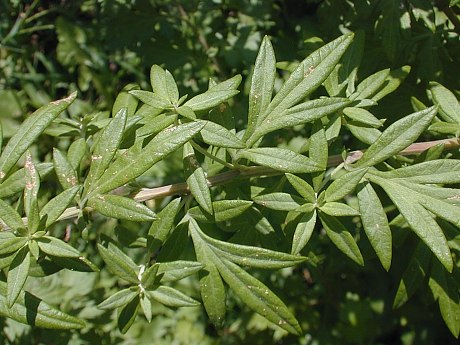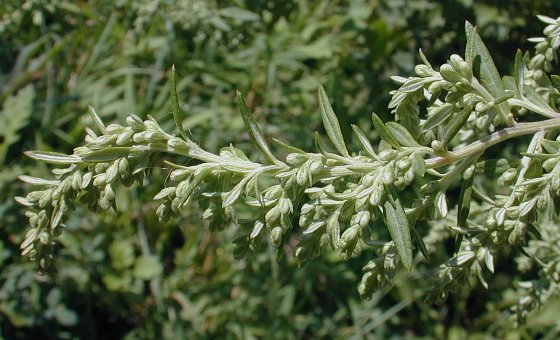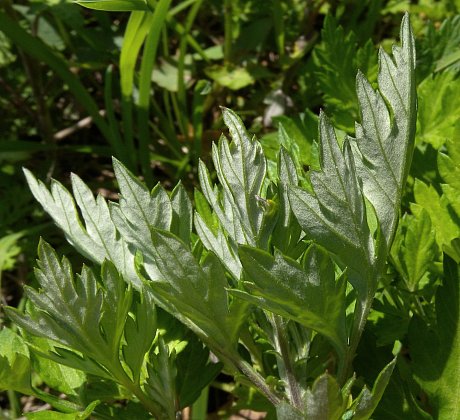Description: This herbaceous perennial plant is 2-4' tall, branching abundantly in the upper half where the flowerheads occur. The stems are largely hairless, angular, and furrowed, although the upper flowering stems are usually pubescent. The lower stems often become reddish or woody in appearance with maturity. The alternate leaves are up to 4" long and 3" across, becoming smaller in size and more narrow as they ascend the stems. The upper surface of these leaves is green and hairless, while their lower surface is white from fine pubescent hairs. The lower and middle leaves usually have 1-2 pairs of deep primary lobes that are often irregularly spaced; these primary lobes are often shallowly cleft by one or more secondary lobes, or they have may a few large teeth. At the base of these leaves, there are often 1 or 2 small eared lobes. The upper leaves have few lobes or none, eventually becoming linear on the flowering stems.

The inflorescence
is a large panicle of leafy spikes with flowerheads. Each flowerhead is
1/8" (3 mm.) across or a little larger, consisting of numerous rayless
florets.
The florets in the center of the flowerhead are fertile and perfect,
while the florets along the outer margin of the flowerhead are fertile
and pistillate. The central florets are tubular with 5 recurved lobes,
while the marginal florets have only 1 or 2 lobes. All of these florets
have a divided style. At the base of the flowerhead are several floral
bracts that are finely pubescent. Except for their abundance, these
flowerheads are inconspicuous. At the bud stage they are whitish green,
becoming dull yellowish green or purplish green with maturity. The
blooming period occurs from late summer to early fall, and lasts about
1 month. Pollination is by wind. Each floret is replaced by an
oblong achene that is without a tuft of hairs. These achenes are small
and light enough to be blown about by the wind. The root system is
quite rhizomatous, and often produces clonal colonies of plants.
Cultivation:
Mugwort prefers full or partial sun and moist to slightly dry
conditions. It adapts well to loam, clay-loam, or gravelly soil, and
slightly acid to alkaline conditions. This plant can spread
aggressively, forming dense colonies that exclude other plants.

Range &
Habitat:
Surprisingly, Mugwort is a rather uncommon plant in Illinois, occurring
in only a few counties in the northern half of the state (see Distribution
Map). It was introduced into the United States from Eurasia
as
an herbal plant. Habitats include areas along railroads, edges of
woods, prairie restorations, herbal gardens, and miscellaneous waste
places. This plant usually occurs in disturbed areas, but it has
displayed a
capacity to invade more natural sites, even when fire is used as a
management tool. This plant may become more of a problem in the future.
Faunal Associations:
The flowerheads attract few insects because they are wind-pollinated.
While the shrubby Artemisia spp. (Sagebrushes) of
the western states are valuable to various kinds of wildlife, birds and
mammals appear to make little use of the herbaceous Artemisia
spp. that occur in the Midwest and NE states. The slightly
aromatic foliage of Mugwort is bitter-tasting and toxic, containing
cinerole and thujone. This latter substance is a neurotoxin. While
Mugwort has been used in herbal medicine in the past, it can cause a
variety of neurological problems and adverse reactions.

Photographic
Location:
Along the edge of a prairie restoration at Meadowbrook Park in Urbana,
Illinois.
Comments:
Mugwort is one of the introduced Artemisia spp. and
rather nondescript in appearance. While significantly lobed, its leaves
are usually broader than other Artemisia spp. and
more tolerant of shade. These leaves are bicolored: green and largely
hairless on the upper surface, but finely pubescent and powdery white
underneath, whereas other Artemisia spp. tend to be
either hairy or glabrous on both sides and less bicolored. Some Artemisia
spp. have hairy or pubescent stems, while the stems of
Mugwort are largely hairless (except for the upper flowering stems).
Mugwort is unusual in having recurved lobes on its central disk florets
– other Artemisia spp. usually have erect or
spreading lobes on their disk florets. Because these florets are quite
small in size, this can be difficult to observe without magnification
from a hand or eye lens.